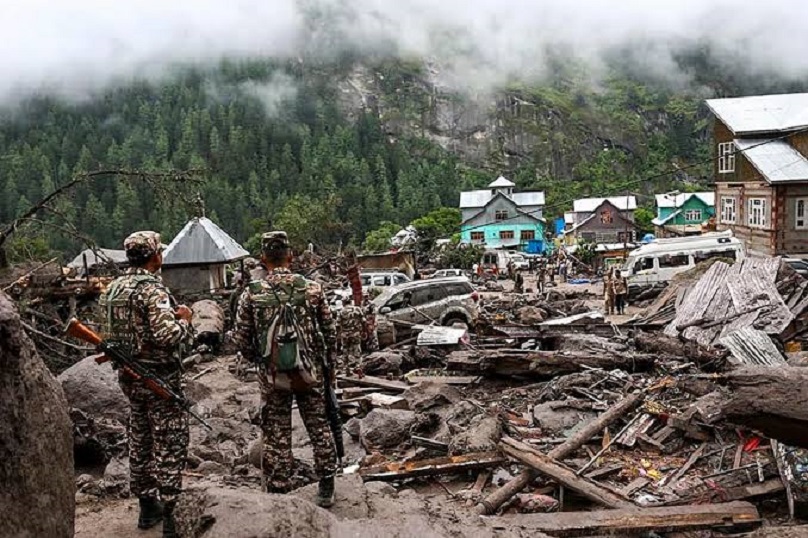Politics
Kishtwar Cloudburst Claims Lives as Preparedness Lags Behind

A devastating cloudburst in Kishtwar, located in the mountainous region of Jammu and Kashmir, resulted in the tragic loss of at least 65 lives with more than 100 people still missing. The sudden rainfall led to the rapid destruction of homes, infrastructure, and entire families, illustrating the catastrophic impact of natural disasters in an area long susceptible to geological instability.
The Kishtwar region is situated in one of the most seismically active zones on Earth. For over 50 million years, the collision of the Indian and Eurasian tectonic plates has created a landscape marked by deep valleys and steep ridges. This geological activity has left the area vulnerable to both earthquakes and landslides. The 2005 Muzaffarabad earthquake, for example, resulted in the deaths of over 80,000 people in the broader region.
Understanding the Risks of Cloudbursts
Cloudbursts are sudden and intense rainstorms that can release over 100 millimeters of rain in just an hour, transforming fragile slopes into torrents of mud and debris. The terrain in Kishtwar, comprised of fractured rock and glacial remnants, is particularly prone to such disasters. Residents find themselves facing the combined threat of climate change, which exacerbates rainfall patterns, and human activities that increase vulnerability.
These extreme weather events are not isolated. The 2010 cloudburst in Leh resulted in over 200 fatalities, while the 2013 Kedarnath tragedy in Uttarakhand was even deadlier, claiming more than 5,700 lives. Each incident serves as a grim reminder of the pressing need for effective disaster preparedness.
The frequency and intensity of such disasters have been rising, particularly in Himachal Pradesh, where landslides and flash floods have claimed numerous lives during monsoon seasons. The increasing toll of these events can largely be attributed to inadequate infrastructure and poor planning practices.
Addressing Infrastructure and Governance Challenges
The Kishtwar disaster underscores the consequences of unchecked development practices. There is a pressing need to implement robust building codes that account for geological risks. Many construction projects in the region have proceeded without proper geological assessments, leading to destabilization of already vulnerable slopes. Road expansion initiatives have compromised hillside stability, while inadequate drainage systems exacerbate runoff issues.
The response to this disaster must also include the establishment of early warning systems that integrate local weather forecasts, rainfall sensors, and slope monitors. These systems should be community-operated to ensure timely alerts reach those in danger.
Public awareness campaigns can educate residents about the signs of impending landslides, such as cracks in walls or changes in water flow, and provide guidance on rapid evacuation protocols. Additionally, restoring native forests can enhance soil stability and mitigate runoff risks.
The challenges posed by the Himalayan geography are formidable, but they are not insurmountable. Proper planning and preparedness can transform how communities engage with their environment. The Kishtwar cloudburst serves as a poignant reminder of the urgent need to prioritize safety and resilience in these vulnerable areas.
As Kishtwar mourns its losses, the focus must shift to actionable strategies that will help prevent similar tragedies in the future. If lessons are learned and appropriate measures adopted, the cycle of devastation may be interrupted, leading to a more resilient future for the region.
-

 World5 months ago
World5 months agoSBI Announces QIP Floor Price at ₹811.05 Per Share
-

 Lifestyle5 months ago
Lifestyle5 months agoCept Unveils ₹3.1 Crore Urban Mobility Plan for Sustainable Growth
-

 Science4 months ago
Science4 months agoNew Blood Group Discovered in South Indian Woman at Rotary Centre
-

 World5 months ago
World5 months agoTorrential Rains Cause Flash Flooding in New York and New Jersey
-

 Top Stories5 months ago
Top Stories5 months agoKonkani Cultural Organisation to Host Pearl Jubilee in Abu Dhabi
-

 Sports4 months ago
Sports4 months agoBroad Advocates for Bowling Change Ahead of Final Test Against India
-

 Science5 months ago
Science5 months agoNothing Headphone 1 Review: A Bold Contender in Audio Design
-

 Top Stories5 months ago
Top Stories5 months agoAir India Crash Investigation Highlights Boeing Fuel Switch Concerns
-

 Business5 months ago
Business5 months agoIndian Stock Market Rebounds: Sensex and Nifty Rise After Four-Day Decline
-

 Sports4 months ago
Sports4 months agoCristian Totti Retires at 19: Pressure of Fame Takes Toll
-

 Politics5 months ago
Politics5 months agoAbandoned Doberman Finds New Home After Journey to Prague
-

 Top Stories5 months ago
Top Stories5 months agoPatna Bank Manager Abhishek Varun Found Dead in Well









